


HANS HOLBEIN 1497 -
xxxxxThe German painter 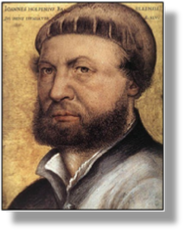 Hans Holbein was born in Augsburg and, as a boy, worked and trained in the large workshop run by his father Hans Holbein the Elder, a recognised artist in the Flemish tradition and an accomplished portrait painter. Showing a remarkable ability at an early age, the young Holbein spent much of his life in Switzerland and England, where, by his design work and portraiture, he came to be regarded as one of the greatest artists of the north European Renaissance. This self-
Hans Holbein was born in Augsburg and, as a boy, worked and trained in the large workshop run by his father Hans Holbein the Elder, a recognised artist in the Flemish tradition and an accomplished portrait painter. Showing a remarkable ability at an early age, the young Holbein spent much of his life in Switzerland and England, where, by his design work and portraiture, he came to be regarded as one of the greatest artists of the north European Renaissance. This self-
xxxxxToday, he is best known for his portraits -
xxxxxIn addition, Holbein also  made designs for jewellery and stained glass, and produced a number of murals, some to decorate the council chamber in the town hall. And it was in the early 1520s that he painted the best of his small number of religious works, including his impressive Dead Christ in the Tomb and his Madonna altarpiece, paintings which, by their composition and richness of colour, suggest the influence of his visit to Italy in 1518.
made designs for jewellery and stained glass, and produced a number of murals, some to decorate the council chamber in the town hall. And it was in the early 1520s that he painted the best of his small number of religious works, including his impressive Dead Christ in the Tomb and his Madonna altarpiece, paintings which, by their composition and richness of colour, suggest the influence of his visit to Italy in 1518.
xxxxxHis skill as a portrait 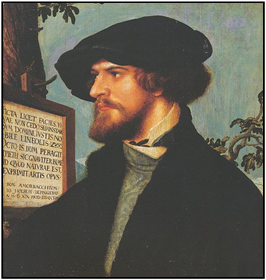 painter was demonstrated as early as 1516 -
painter was demonstrated as early as 1516 -
xxxxxThen after a short stay in Basel, where 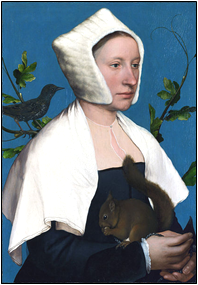 the reformation was set on “purifying” art, he returned to England in 1532 and stayed there for the rest of his life. Very soon, his painting of The French Ambassadors -
the reformation was set on “purifying” art, he returned to England in 1532 and stayed there for the rest of his life. Very soon, his painting of The French Ambassadors -
xxxxxHolbein’s portraits are works 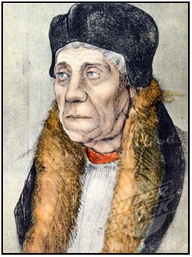 of refinement and the products of a keen sense of observation. Every minute detail is accurately recorded, be it the colour of flesh or hair, the texture of cloth or lace, or the decorative accessories included, such as rings and necklaces. The result was an astonishing realism which, in most cases, provided some degree of insight into the character of the sitter. His main aim, however, was not to provide some sort of psychological study of his subject, but to portray in studied detail the opulent members of court, high society and the rising merchant class. He certainly achieved that. The sketch shown here is of William Warham, Archbishop of Canterbury, and was produced in 1527 as a preparatory sketch for a portrait. It is one of his most brilliant character studies.
of refinement and the products of a keen sense of observation. Every minute detail is accurately recorded, be it the colour of flesh or hair, the texture of cloth or lace, or the decorative accessories included, such as rings and necklaces. The result was an astonishing realism which, in most cases, provided some degree of insight into the character of the sitter. His main aim, however, was not to provide some sort of psychological study of his subject, but to portray in studied detail the opulent members of court, high society and the rising merchant class. He certainly achieved that. The sketch shown here is of William Warham, Archbishop of Canterbury, and was produced in 1527 as a preparatory sketch for a portrait. It is one of his most brilliant character studies.
xxxxxBecause of his attention to detail, Holbein produced some magnificent miniature portraits, and he was responsible for introducing this type of work into England. These miniatures, examples of which are housed in the Victoria and Albert Museum in London, had a marked influence on the work of Nicholas Hilliard, who became miniature painter to Elizabeth I in about 1570.
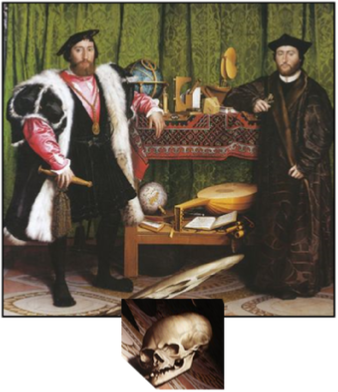
xxxxxIncidentally, Holbein’s famous work The French Ambassadors, mentioned above, has puzzled viewers ever since it was painted in 1533. It shows two well-
xxxxxShown here (left to right) are four drawings – Henry VIII, The Hands of Erasmus, The Head of a Woman, and Anne Boleyn – and a wood engraving The Dance of Death.
xxxxxThe German painter Hans Holbein was a talented book illustrator, designer and woodcut artist as well as a portrait painter of exceptional ability. For example, he provided pen and ink sketches for In Praise of Folly, the work of the Dutch humanist Erasmus, and he produced a brilliant series of wood-




Acknowledgements
Holbein: Self-
H8-